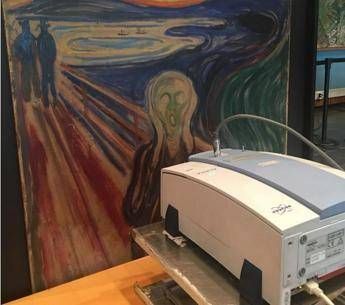The conservation of paintings and other works of art is a noble task. Many people enjoy visiting museums and galleries and it’s safe to say future generation will too. However, the public display is putting such artwork in serious danger, and this is not just about theft or vandalism.
It is about air, water and light. All these basic things put oxidative stress on the materials used to create wonderful art. Over time, these three elements will harm most organic matter.
As a result, understanding the processes behind the degradation of colors, binders, canvas, etc. is part of the routine work in protecting, restoring and preserving artwork.
Edvard Munch’s: The Scream
Recently, scientists led by the CNR took a closer look at the degradation processes taking place in Edvard Munch’s famous paining “The Scream”. Slowly, the colors in some regions of the 1910 version are fading. Therefore, due to its delicate condition, the painting was rarely used in exhibitions.
This is why researchers aimed to find the optimal preserving conditions to make “The Scream” available to the public more often! Among other techniques, the research team applied non-invasive spectroscopic methods to reveal the origins of the fading process.

Credits: MOLAB (CNR-SCITEC, Italia)
The path to the right conclusions was complex …
First, the European MOLAB platform brought portable instruments to the Munch Museum in Oslo. Later, very small fragments were taken from Munch’s work and analyzed at the European synchrotron facility in Grenoble, France.
The chemical analysis showed that the usually bright and yellow cadmium sulfide was slowly turning into colorless cadmium sulfate. This happened in the presence of chlorine-containing substances and at high relative humidity. Most importantly however: even in the absence of light.
In fact, the presence of light had an irrelevant impact on the process and the main culprit in this degradation process was identified to be: water.
… but it led to better conservation of paintings!
Fortunately, the research now provides the painting’s conservatories with instructions for “permanently exhibiting” the painting in safe conditions. Exposure should be limited to relative humidity not higher than 45% and the lighting should meet the standards for pictorial materials stable to light.
Lastly, this research may also help to preserve other paintings too as cadmium sulfide based colors are used in many works of art. This includes works by Henri Matisse, Vincent van Gogh and James Ensor.
There are many cases, where FTIR spectroscopy took part in preserving our cultural heritage. Our blog features the analysis of finest carrera marble. So take your time to explore or visit our website to learn more about spectroscopy, arts and conservation.








